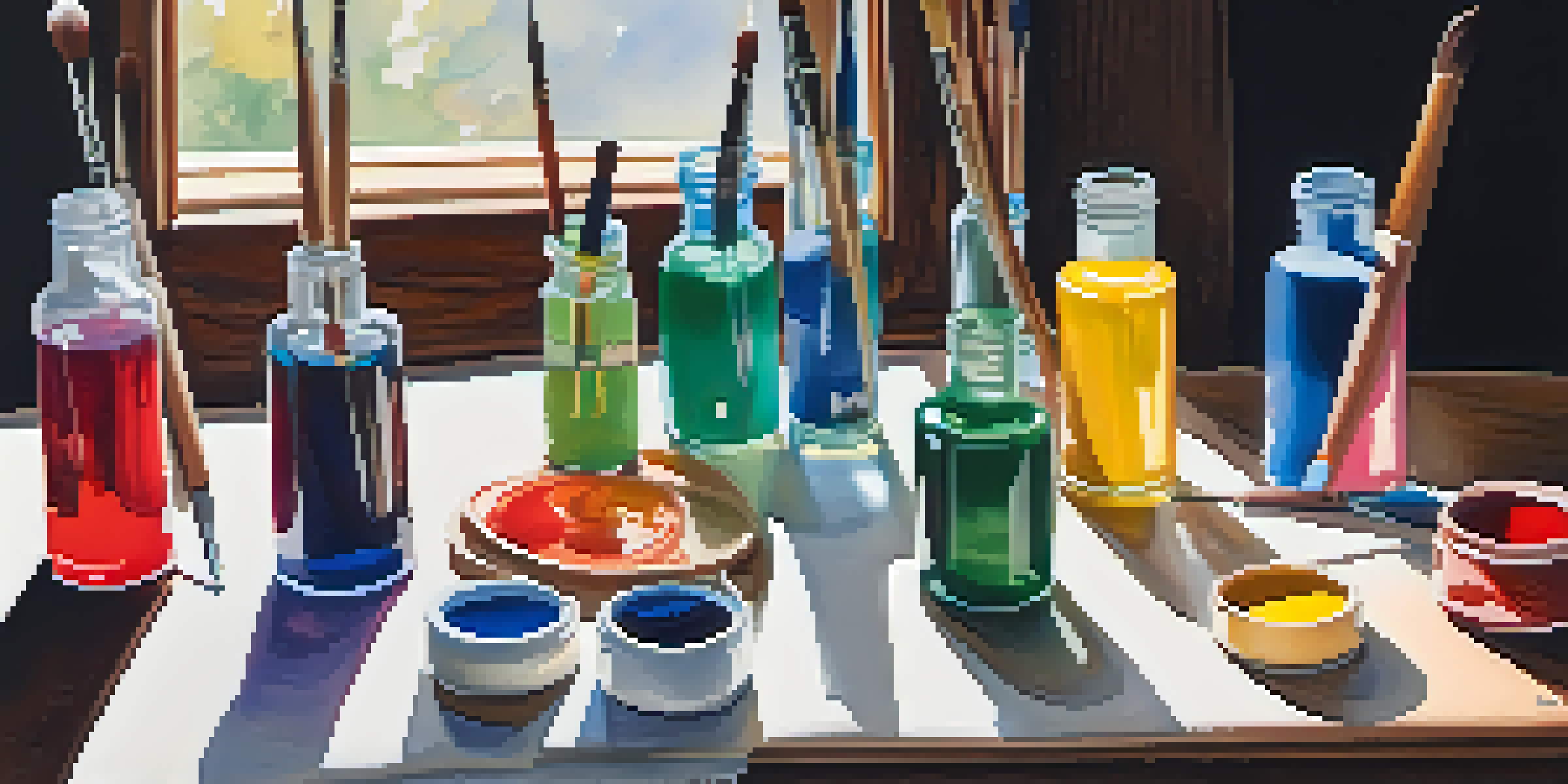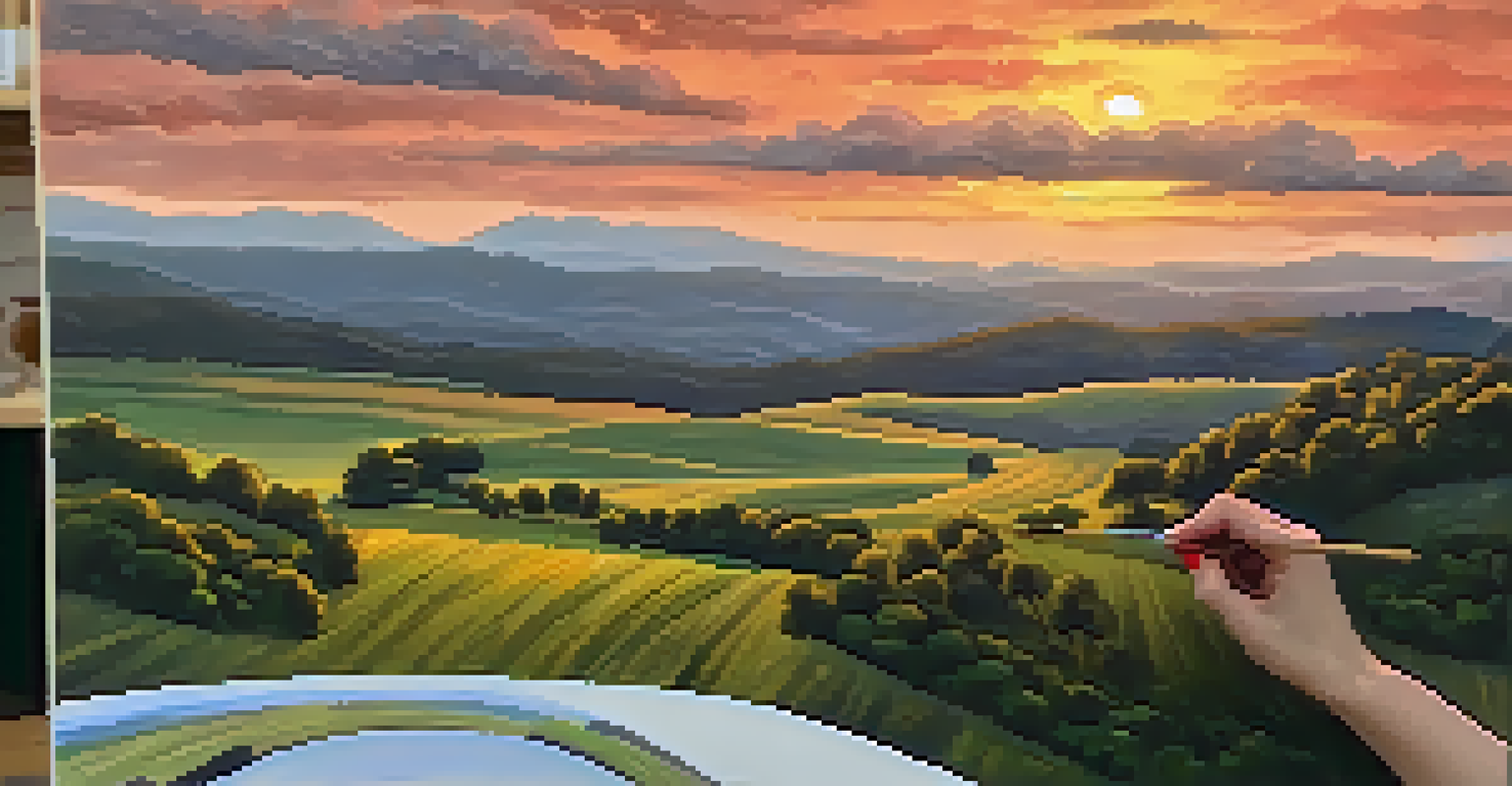Understanding the Basics of Gouache: Techniques for Success

What is Gouache? A Brief Introduction to the Medium
Gouache is a water-based paint that combines the qualities of watercolor and acrylic. Unlike watercolors, gouache is opaque, meaning it can cover underlying layers effectively. This attribute allows artists to achieve vibrant colors and solid coverage, making it a favorite among illustrators and fine artists alike.
Color is the keyboard, the eyes are the harmonies, the soul is the piano with many strings.
The history of gouache dates back centuries, with roots in ancient Egypt and later popularity in European art. It was often used for illustrations and designs, bringing a unique blend of color and texture to artworks. Understanding its origins can deepen your appreciation for this versatile medium.
One of the most appealing aspects of gouache is its ease of use. Whether you're a beginner or an experienced artist, gouache offers a forgiving nature that allows for layering and blending. This makes it an excellent choice for explorative artists looking to expand their skills.
Essential Supplies for Gouache Painting
To get started with gouache, you'll need a few key supplies: gouache paints, brushes, watercolor paper, and a palette. Gouache paints come in tubes or pans, and choosing high-quality brands can make a significant difference in your results. Look for paints that offer a rich pigmentation and smooth application.

Brushes are equally important; opt for synthetic or natural hair brushes that hold water well. Flat brushes work great for broad strokes, while round brushes are perfect for details. Remember to have a range of sizes on hand to accommodate different techniques and styles.
Gouache: A Unique Painting Medium
Gouache is a versatile water-based paint that combines the opacity of acrylics with the fluidity of watercolors, making it ideal for both beginners and experienced artists.
Lastly, using the right paper is crucial. Watercolor paper is ideal due to its weight and texture, which can handle the water content in gouache. Choose a cold-pressed paper for more texture or hot-pressed for a smoother finish, depending on your artistic vision.
Basic Gouache Techniques Every Artist Should Know
There are several fundamental techniques that can elevate your gouache painting skills. One popular method is layering, where you apply thin washes of color and gradually build up opacity. This technique creates depth and vibrancy in your work, allowing for stunning visual effects.
Every artist dips his brush in his own soul, and paints his own nature into his pictures.
Another essential technique is wet-on-wet, where you apply wet gouache onto wet paper or existing layers. This method creates soft edges and allows colors to blend seamlessly. Experimenting with this approach can lead to beautiful, unpredictable results that enhance your artwork.
Don't forget about dry brushing, which involves using a dry brush to apply a small amount of paint. This technique can add texture and detail to your pieces, making it perfect for creating highlights or rough surfaces. Each of these techniques can be combined for unique outcomes.
Mixing Colors: Tips for Achieving Vibrant Hues
Mixing colors in gouache can be both fun and rewarding. A basic understanding of color theory will help you create dynamic palettes for your artwork. Start by familiarizing yourself with primary, secondary, and complementary colors, as these relationships will guide your mixing process.
When mixing gouache, use a palette to keep your colors organized. Begin with a small amount of each pigment, gradually blending them together until you achieve the desired shade. Remember that gouache dries darker than it appears when wet, so keep this in mind as you mix.
Essential Supplies for Gouache Art
To start painting with gouache, you'll need key supplies including high-quality gouache paints, appropriate brushes, and watercolor paper.
To add depth to your palette, consider mixing complementary colors to create muted tones. This technique can bring harmony to your artwork and prevent colors from becoming too overpowering. The more you practice mixing, the more intuitive it will become.
Common Mistakes and How to Avoid Them
Even experienced artists make mistakes with gouache, but recognizing and learning from them is key. One common pitfall is using too much water, which can dilute the paint and lead to a washed-out appearance. Instead, use water sparingly to maintain the vibrancy of your colors.
Another frequent error is not allowing layers to dry properly before applying new ones. This can cause colors to muddy and lose their integrity. A good rule of thumb is to wait until the previous layer is completely dry before adding additional details or layers.
Lastly, be cautious with your brush techniques. Overworking the paint can lead to a muddy finish, so try to apply deliberate strokes and avoid excessive blending. Embracing the uniqueness of each stroke can lead to beautifully imperfect results.
Caring for Your Gouache Supplies
Proper care for your gouache supplies can significantly extend their lifespan and enhance your artistic experience. After each painting session, make sure to clean your brushes thoroughly to prevent paint from drying and ruining the bristles. Rinse them in warm water and reshape the tips before storing them.
For your gouache paints, keep the lids tightly sealed to prevent them from drying out. If you find that your gouache has thickened, a few drops of water can help revive it. Just be cautious not to add too much water, as this can alter the paint's consistency.
Key Techniques for Gouache Mastery
Fundamental techniques like layering and wet-on-wet application can enhance your gouache painting skills and lead to stunning visual effects.
Lastly, store your paints and brushes in a cool, dry place away from direct sunlight. This will help maintain their quality and performance, ensuring that you're always ready to create stunning works of art.
Inspiration: Famous Artists Who Use Gouache
Many renowned artists have embraced gouache in their work, showcasing its versatility and unique qualities. For instance, French artist Henri Matisse is famous for his vibrant gouache cut-outs, where he combined color and form in striking ways. His innovative approach continues to inspire artists around the world.
Another notable figure is the American illustrator Mary Blair, whose bold use of color and whimsical designs for Disney have left a lasting legacy. Her gouache illustrations brought stories to life, demonstrating the medium's ability to evoke emotion and narrative.

These artists remind us that gouache can be a powerful tool for self-expression. Exploring their work can provide valuable insights and ignite your own creativity, encouraging you to experiment and find your unique style.